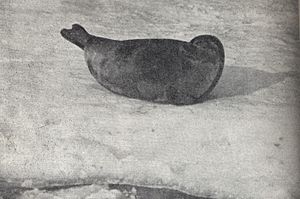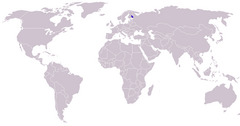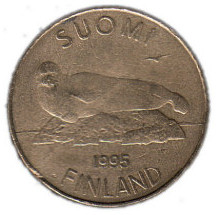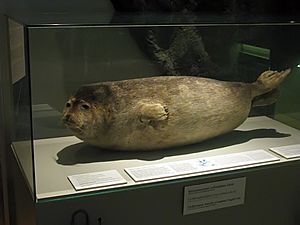Saimaa ringed seal facts for kids
Quick facts for kids Saimaa ringed seal |
|
|---|---|
 |
|
| Conservation status | |
| Scientific classification | |
| Kingdom: | |
| Phylum: | |
| Class: | |
| Order: | |
| Family: | |
| Genus: |
Pusa
|
| Species: | |
| Subspecies: |
P. h. saimensis
|
| Trinomial name | |
| Pusa hispida saimensis (Nordquist, 1899)
|
|
 |
|
| Synonyms | |
|
|
|
The Saimaa ringed seal (Pusa hispida saimensis) is a special type of ringed seal. Most seals live in the sea, but Saimaa ringed seals live only in Lake Saimaa in Finland. There are only about 320 Saimaa ringed seals left in the world. This makes them one of the most endangered seals on Earth.
After the last ice age ended, the land slowly rose. This cut off Lake Saimaa from the sea. Some seals were trapped in the lake. Their descendants became the Saimaa ringed seals we know today.
Contents
Where Saimaa Ringed Seals Live
Their Home: Lake Saimaa
The Saimaa ringed seal's only home is Lake Saimaa in Finland. This large lake is about 180 km long and 140 km wide. It covers an area of 1,147 square kilometers (443 sq mi). The lake is not very deep, usually around 12 meters (39 ft). Its deepest point is 85 meters (279 ft).
Lake Saimaa has about 13,000 islands and over 14,850 km (9,227 mi) of shoreline. The lake freezes over from November to May. This means the seals have two types of homes: an ice home in winter and an open water home in summer. The frozen lake, with its many islands, creates a maze-like place for the seals. In summer, when the ice melts, the islands give them plenty of space to rest and have their pups.
Their Limited Range
Saimaa ringed seals are named after Lake Saimaa because it is their only habitat. They live only in the waters of Lake Saimaa and its nearby shores.
What Saimaa Ringed Seals Look Like
An adult Saimaa ringed seal is usually between 85 and 160 centimeters (2.8 to 5.2 ft) long. They weigh from 50 to 90 kilograms (110 to 200 lb). Male seals are generally bigger than females.
These seals are dark gray. They have a gray-black back with circular white rings. Their belly is light gray. Saimaa ringed seals are darker in color compared to other types of ringed seals.
What Saimaa Ringed Seals Eat
Saimaa ringed seals eat only fish. They are not picky eaters and will eat different kinds of small fish. The fish they eat are usually about 8.6 cm (3.4 in) long, but can be up to 21 cm (8.3 in). Baby seals eat slightly smaller fish than adults.
Most of their diet includes fish like vendace, smelt, perch, and roach. Young seals mostly eat perch and roach. These fish are found in the shallow waters where the pups spend most of their time. Adult seals eat more vendace and smelt.
For a long time, people thought Saimaa ringed seals ate too many fish. They worried the seals were competing with local fishing. However, studies have shown that these seals do not harm the fishing industry. They do not eat endangered salmon. Even though they eat vendace, they do not eat enough to affect the overall vendace population.
Saimaa Ringed Seal Behavior
Reproduction and Life Cycle
Ringed seals are pregnant for 11 months. Their pups are born weighing 4 to 5 kilograms (8.8 to 11.0 lb). They are about 55 to 65 centimeters (1.8 to 2.1 ft) long at birth. Saimaa ringed seals can live for just over 20 years.
Diving Habits

Diving is very important for seals. They dive to find food and to travel. The length of their dives increases from spring to autumn. This might be because there is more food available. It is interesting because they are one of the few seal species that live in a lake, not the ocean.
Scientists have studied Saimaa ringed seal diving a lot. They found that the seals can hold their breath longer than expected. Their longest recorded dive lasted 15 minutes. This long dive is thought to be a resting dive where they use less energy.
Saimaa ringed seals usually dive 10 to 15 meters (33 to 49 ft deep). However, how deep they can dive depends on how deep the lake is in that area. The seals also have special patterns for resting out of the water, called hauling-out. In May and June, when they are molting (shedding their fur), they rest on land both day and night. In late summer, they only rest on land at night.
Saimaa ringed seals can dive and find their way in the dark lake because of their very sensitive vibrissae. These are their whiskers. Using their whiskers, they can sense sounds and pressure changes in the water. This helps them navigate in their dark environment.
Images for kids
See also
 In Spanish: Foca anillada de Saimaa para niños
In Spanish: Foca anillada de Saimaa para niños




